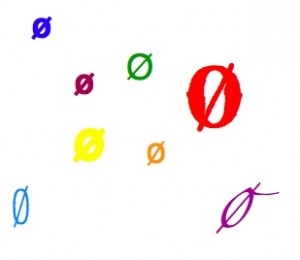 If letters had a national identity, Ø would doubtless be Miss Denmark. Æ is shared with the Norwegians and Icelanders and indeed the whole world in fancy ways of writing Latin words (Cæsar, right?) Å just recently found its place in the Danish alphabet, and is still often written ’Aa’ in placenames, such as Aalborg rather than Ålborg. Ø, on the other hand, has been in Denmark since the Middle Ages, and its use beyond Denmark, Norway and the Faroe Islands is limited to technical stuff (as a symbol for ’diameter’) and trademarks like the tonic Nørdic Mist. (Guess it makes it look ”Nordic” somehow.)
If letters had a national identity, Ø would doubtless be Miss Denmark. Æ is shared with the Norwegians and Icelanders and indeed the whole world in fancy ways of writing Latin words (Cæsar, right?) Å just recently found its place in the Danish alphabet, and is still often written ’Aa’ in placenames, such as Aalborg rather than Ålborg. Ø, on the other hand, has been in Denmark since the Middle Ages, and its use beyond Denmark, Norway and the Faroe Islands is limited to technical stuff (as a symbol for ’diameter’) and trademarks like the tonic Nørdic Mist. (Guess it makes it look ”Nordic” somehow.)
When Danes can’t find Ø on the keyboard, they write ’oe’. (Or use the zero symbol, if they happen to be my cousin.) Like Æ, it was originally a ligature (two letters whacked together). You may have seen the French ligature Œ. This is what the letter ought to have looked like. But somehow the E part became a diagonal in Danish. (And two dots in Swedish and German: Ö.)
Ø, famously – in Scandinavia at least – is one of only three letters which can also act as an independent word in Danish. It means ’island’, and you can find it as an ending in many Danish island names: Christiansø, Ærø, Tunø, Fanø…
(The other one-letter words are å, which means a ’small river’, i, the preposition ’in’, and I, which is the plural ’you [guys]’.)
 Ø is a pretty letter, that you’ll love to tweak if you be one of dem calligraphers… In any Danish butik (shop) selling food items, you’ll find a lot of things marked with an Ø. That means the spaghetti package you’re holding in your hand is an økologisk (organic) product. Indeed, many Danes associate the letter Ø with all things ”øko”, that is, grown and produced in a way that is thought to be friendlier to the environment.
Ø is a pretty letter, that you’ll love to tweak if you be one of dem calligraphers… In any Danish butik (shop) selling food items, you’ll find a lot of things marked with an Ø. That means the spaghetti package you’re holding in your hand is an økologisk (organic) product. Indeed, many Danes associate the letter Ø with all things ”øko”, that is, grown and produced in a way that is thought to be friendlier to the environment.
In short, without its Ø, Danish culture would certainly collapse. There would be no øl (beer)!
Tomorrow’s special letters special will conclude this series with Å…





